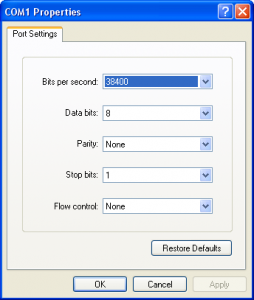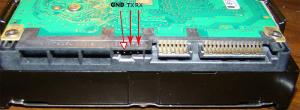Content Type
Profiles
Forums
Events
Everything posted by VideoRipper
-
No offence CrazyDoctor (I already told you earlier I do like you), but isn't it a bit weird you're looking for specialist's tools/solutions all the time with a very hefty pricetag, without even being able to understand (let alone resolve) very sophisticated technical problems? Apart from that, you're expressing that you're considering to pay $2000 for a device (you don't even know to operate), but not for the updates These tools aren't magic "Just plug a defective device in, press a button and everything will get repaired"-devices, but (as the name suggests): "Tools"... they *can* help you in solving a certain problem (after first having diagnosed the cause of that problem). Just like, for instance, a screwdriver or a wrench: in the hands of a n00b they're useless. Most of the time, things can be perfectly repaired/resolved using very simple and cheap solutions. The only difference between a "Real"/"Official"- and a "Poor man's"-solution is that it will take a little more effort using the cheap option (though you will learn a lot from it). See the Seagate 7200.11 topics for a real-life example. You can, for instance, buy a MPLab PIC-programmer for $900, but a "Poor man's" one will only set you back less than $9 and a couple of hours of carefully re-checking everything before flashing. Only when you're ready to start up your own "Harddrive-repair" bussiness (after having fiddled and experimented for a long time), it's worth to buy specific specialists tools. There's no sense in buying a "Belzer/Gedore" (a well known European manufacturer of quality tools) screwdriver or wrench when your only intention is to use it to repair your bike once; just get a "Kinzo" instead... Greetz, Peter.
-
You should first do a SpeedTest.net-test to get your actual (approximate) speeds. (First stop all up- and downloads like UseNet, P2P, etc. before starting the test) After the test, post the image here (just copy-and-[aste the forum-link that is given): A download-accelerator *might* improve your download-speed, since it will perform a download using several slots at once; however, if that improves speeds with all sites (like for instance the one from Microsoft), you should really ask yourself if there's nothing wrong with your set-up... I get around 5MByte/s downloading from MS using only 1 slot. I can't recommend anything for FireFox, since I'm a stubborn IE7 user Greetz, Peter.
-

Some questions related to external harddisk
VideoRipper replied to morland's topic in Hard Drive and Removable Media
First you should ask yourself this question: "Why do I have/need to convert my external FAT-drive to NTFS?" When the answer is "Because I want to store files larger than 4GB" or "Because I want to encrypt the drive's partition" then I would say: "Do it". If it's because you think it's "Better", "Faster" or "More modern"... dont' Personally, I never use NTFS on external USB- or NAS-drives, for various reasons, but maybe others can give you better advice? (A certain Italian guy comes to mind) Greetz, Peter. -

Need help with broken CD + Pic
VideoRipper replied to CrazyDoctor's topic in Hard Drive and Removable Media
No offence CrazyDoctor (I actually do like you), but you amaze me every day with the broken things you own and (want to) try to fix. I've seen a lot of extremely broken things in my life, but not in such a short time-span after each other. Greetz, Peter. -
I'm afraid you'll get the exact same answers here as in your previous (similar) question All webbased (graphical) games you can find on the net are written in Flash (actionscript, ...) (At least: I've never seen, or know about, internet-games that were written in another language) So you're going to need some ActionScript skills (takes some years to become better than average... at least) and a lot of graphical/designing skills (could take even longer to get succesful at it, apart from the fact that you'll need to have some talent for it). Greetz, Peter.
-

The Solution for Seagate 7200.11 HDDs
VideoRipper replied to Gradius2's topic in Hard Drive and Removable Media
Well, my Chinese is a bit rusty, so I don't know either It looks like you haven't set the correct baudrate (or any of the other settings), but it's a bit hard to tell with these Chinese characters. The correct settings should be: You might even have forgotten to properly the ground wires or swapped the TX- and RX-line. What RS232 -> TTL convertor are you using, BTW, I hope it's not a CA-42 Greetz, Peter. -

Have a trouble with randomally disconected HD
VideoRipper replied to CrazyDoctor's topic in Hard Drive and Removable Media
Like allan2 said: keep it cool, even if it isn't really at the temperature reported. Probably the temperature-sensor is defective, forcing the drive to shut off. By cooling it down pretty low (maybe you want to use a table fan pointing at it) you might be able to retrieve the data by using the tips suggested by jaclaz. B) -

Any good network monitoring tools that are free?
VideoRipper replied to dubsdj's topic in Networks and the Internet
Granted, it has been around 15 years ago I did this, but you can monitor traffic from/to other computers by using an old Hub The only real problem is that your maximum network throughput will be limited to 10Mbit, but it is cheap if you can get a hold on such an ancient device. FYI: An Ethernet network hub is an old type of "Switch", with no intelligence at all built-in like present day switches have. Because there's no intelligence in them, all data is present on all ports and connected devices (computers, N/W-printers, etc.) had to filter out their own packets from the network. So when you connect your PC to a hub you can listen in on all traffic -

Any good network monitoring tools that are free?
VideoRipper replied to dubsdj's topic in Networks and the Internet
You know these two contradict each other? As with a lot of these kinds of things, there are no one-click-solves-all solutions (see my first statement above) -
Even more confusing:
-
...and when the website is using domain-wide cookies, you can add an entry like: http://*.testsite.com/ This way everything belonging to testsite.com will be allowed, like: http://www.testsite.com/ http://store.testsite.com/ http://payment.testsite.com/ http://services.testsite.com/ etc., etc. Greetz, Peter.
-
It's because you have been fooling around with the services On a command-prompt, type: tasklist /svc to see what services have been started by svhost (under the "Services"-column in the list that is shown). You can compare that list with the services you have been enabling (the ones that are missing are likely the culprit). I'm sure there are easier solutions/ways, but I hardly ever have this problem. Your event-log will most likely also list some errors of services that refused to start Greetz, Peter.
-
Hehehehe, worthless on my old hardware Both A/V are stuttering, luckilly I never play 35Mbit streams AMD Atlon 64 3400+ 2.40GHz, 2.50GB NVidea GForce 6800, 128MB Windows XP Pro SP3 Windows Media Player 11 (A/V stutter) Haali Media Matroska Splitter v1.9.355.21 FFDShow tryouts rev 3207 (Jan 18, 2010) VLC (only audio) Greetz, Peter.
-
Have you tried MagicISO? Greetz, Peter.
-
Any info on the used Outlook version and are you using FAT or NTFS (2GB issue)? What does the logging tell you? (Enable Outlook logging) Greetz, Peter.
-

Seagate Barracuda 7200.11 Troubles
VideoRipper replied to Zenskas's topic in Hard Drive and Removable Media
Ah... those In my opinion, it's better to cover either only the actuator/heads contacts or just both contacts (or remove the PCB completely) at the beginning of the procedure for this very simple reason: The contacts in the middle are for the platter-motor and the one on the side is for the actuator-arm and the heads. When only covering the middle (motor) contacts, the platters will not spin, but the actuator/heads will move over the platters. Since, under normal circumstances, the heads are "Flying" above the platters induced by a thin layer of air, they will not get in contact with each other. But... if you would disconnect the motor, the platters will not spin and therefor the heads will not hover above the platters which could *potentially* have dramatic consequences (heads crashing onto platters) But... this is just based on what I know about the internals of harddrives. Greetz, Peter. -

The Solution for Seagate 7200.11 HDDs
VideoRipper replied to Gradius2's topic in Hard Drive and Removable Media
Hi Zosch, First of all I suggest you thoroughly read the instructions, since I'm under the impression you've only picked up some highlights from the procedure and are getting things messed up Not all solutions need an external battery; an external battery is only needed to power the RS-232 <=> TTL convertor, if applicable. Tell us what convertor you'll be using and we can supply you with the correct answer. While performing the debricking you need to supply power using the SATA-power port using a normal PC-power supply (ie. +12V, +5V and GROUND). Greetz, Peter. -

The Solution for Seagate 7200.11 HDDs
VideoRipper replied to Gradius2's topic in Hard Drive and Removable Media
Great to hear another success-story, blackbelt007! Please remember that doing a firmware update might not solve the actual problem, and you should preferably just swap the drive now while it's still under warranty. That looks like a good choice indeed and you will certainly be able to "Talk" to the drive using it, however don't forget to externally supply power to this board between the VCC- and GND-lines Since your drive has a somewhat different firmware-version, the given procedure here *might* not work, so be carefull Please keep us updated! Greetz, Peter. -

Seagate Barracuda 7200.11 Troubles
VideoRipper replied to Zenskas's topic in Hard Drive and Removable Media
I'm not sure I understand your question What other connectors are you talking about, other than these: and what do you need to know about them, other than how to connect a TTL-serial device to the diagnostics port? Greetz, Peter. -

The Solution for Seagate 7200.11 HDDs
VideoRipper replied to Gradius2's topic in Hard Drive and Removable Media
Easier for who? I don't know all possible solutions from the top of my head, I just built a RS232 <-> TTL convertor myself on a piece of Veroboard with a MAX232, so I could use my on-board COM-port, to de-brick my drive. I don't expect others to (be able to) do the same, but the least you could do is doing some work (and research) yourself, like using Google as Salami suggested or scroll back a few pages in this thread. As a last resort you could also ask around here for people that live in your neighbourhood and successfully debricked a drive in the past; I'm sure a sixpack of beer would do wonders... Greetz, Peter. -

The Solution for Seagate 7200.11 HDDs
VideoRipper replied to Gradius2's topic in Hard Drive and Removable Media
Ah... that dreadful CA-42 cable again Like already mentioned a couple of times in this thread, we can't offer any real help when using this type of cable, since there are a lot of different (clone) manufacturers out there, all using their own way of doing things and each with their own shortcomings, opposed to a "Real" Nokia CA-42 cable. Some do need an external (3V) power supply, some don't, while others are only able to communicate at 9600 Baud (which is too slow for our use). Unless you're at least a bit knowledgable in electronics, there's no easy and fool-proof answer to give when using it. Please have a look at this READ_ME_FIRST-thread, under "10. CONVERTORS (or Data Cables)": I suggest you either seek help from someone with electronics knowlegde or get yourself a device that is guaranteed to work, even for the less experienced. There are a few pointers in this thread of people that have debricked their drive successfully with a ready made and easilly obtainable device. Don't forget this is "Higher level" electronics we're talking about here, which can't be compared to things like replacing a light-bulb or installing a TV. Greetz, Peter. -

The Solution for Seagate 7200.11 HDDs
VideoRipper replied to Gradius2's topic in Hard Drive and Removable Media
Upto now, this is all the information you've posted: ...not much to go on, is it? I don't know what kind of system you're using, what OS, what USB-RS232 adapter, what driver(s) you're using, whether the COM-port is (potentially) in use by another application, what other processes are also running, what your technical knowlegde is, ... The only thing I do know is that your PC is not able to "Open COM 3", which is just as vague as saying that the engine of your car isn't running and you're asking the guy of the garage over the phone why... We need a bit more information to go on. Greetz, Peter.




